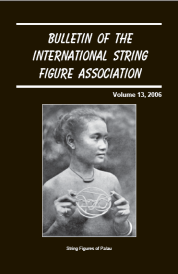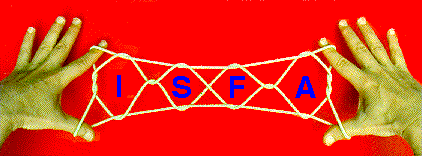Volume 13 (2006): 190 pages - Table des Matières
Edité par - Mark A. Sherman, Pasadena, California
Rédacteurs Associés - Joseph D'Antoni, Queens, New York; Myriam Namolaru, Haifa, Israel;
Belinda Holbrook, Davenport, Iowa; Stephan Claassen, Best, Netherlands.
Comité de Rédaction - Hiroshi Noguchi, Tokyo, Japan; Philip Noble, Inverness, Ecosse
Le Bulletin de l'Association Internationale du Jeu de Ficelle (BISFA) est une publication savante
présentant des documents originaux qui fait progresser notre compréhension et renforce
notre plaisir des jeux de ficelle. BISFA est publié annuellement, en septembre, par ISFA Press
(Pasadena, Californie). BISFA remplace le Bulletin de l'Association des Jeux de Ficelle,
(Toky Nippon Ayatori Kyokai), qui a été publiée en 19 volumes (1978-1993).
Les traductions proposées ne comprennent pas les illustrations et photos du texte original.
J'ai traduit ces textes pour vous donner un aperçu de la qualité et de la richesse de
ces publications.

Special Issue
- The String Games and Cat’s Cradles of Palau, collected by P. Raymund Laile, O. Cap.; translated by Axel Reichert, Bad Oldesloe, Germany; distribution analysis by Joseph D'Antoni, Queens, New York; introduction and reconstructed methods by Mark Sherman, Pasadena, California (pages 1-163) - P. Raymund’s massive collection of string figures from Palau was published nearly a century ago in the widely-read journal Anthropos (1911, Vol. 6, pages 40-61). It is an important article that documents a wide variety of complex and previously unrecorded designs from a region that is pivotal in understanding how string figures diffused across the globe. Nevertheless it has been largely ignored by the string figure community for two reasons: 1) the article is written in German; and 2) the author failed to collect methods for making the 101 designs he photographed. In this special issue the editors present an English translation of Raymund’s article, reconstructed methods for making all the figures in the collection, and a preliminary distribution analysis. Based on the analysis, it appears that only thirty-eight of the designs in the collection have been recorded elsewhere in Oceania. The remaining sixty-three are either variations of previously observed figures or entirely new designs that were created by shuffling and combining well-known Oceanic technique sequences.
Nomenclature - by Mark Sherman (pages 164-190)
- Illustrations pas à pas pour réaliser sept jeux de ficelle océaniques (Fleur du Takamaka , Maison Papouasienne , Feu et Fumée , Baudet Riant , Croissant de Lune , Le Baiser , and Rat sur le Toit ) sont donnés en exemples.
Ajouter un commentaire


